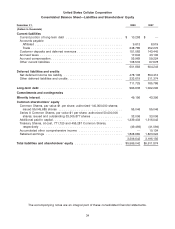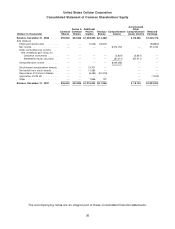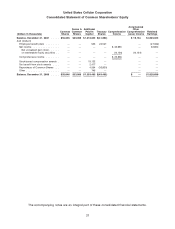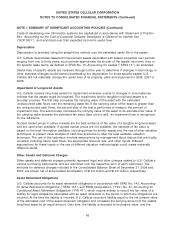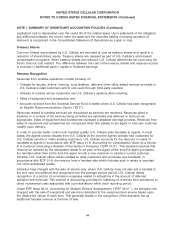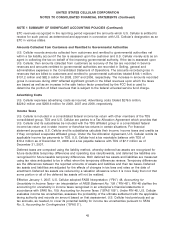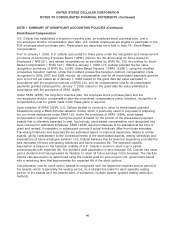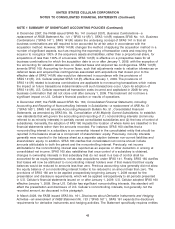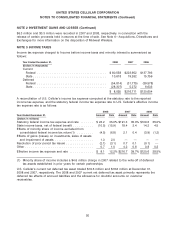US Cellular 2008 Annual Report Download - page 165
Download and view the complete annual report
Please find page 165 of the 2008 US Cellular annual report below. You can navigate through the pages in the report by either clicking on the pages listed below, or by using the keyword search tool below to find specific information within the annual report.UNITED STATES CELLULAR CORPORATION
NOTES TO CONSOLIDATED FINANCIAL STATEMENTS (Continued)
NOTE 1 SUMMARY OF SIGNIFICANT ACCOUNTING POLICIES (Continued)
Costs of developing new information systems are capitalized in accordance with Statement of Position
98-1, Accounting for the Cost of Computer Software Developed or Obtained for Internal Use
(‘‘SOP 98-1’’), and amortized over their expected economic useful lives.
Depreciation
Depreciation is provided using the straight-line method over the estimated useful life of the assets.
U.S. Cellular depreciates leasehold improvement assets associated with leased properties over periods
ranging from one to thirty years; such periods approximate the shorter of the assets’ economic lives or
the specific lease terms, as defined in SFAS No. 13, Accounting for Leases (‘‘SFAS 13’’), as amended.
Useful lives of specific assets are reviewed throughout the year to determine if changes in technology or
other business changes would warrant accelerating the depreciation for those specific assets. U.S.
Cellular did not materially change the useful lives of its property, plant and equipment in 2008, 2007 or
2006.
Impairment of Long-lived Assets
U.S. Cellular reviews long-lived assets for impairment whenever events or changes in circumstances
indicate that the assets might be impaired. The impairment test for tangible long-lived assets is a
two-step process. The first step compares the carrying value of the asset with the estimated
undiscounted cash flows over the remaining asset life. If the carrying value of the asset is greater than
the undiscounted cash flows, the second step of the test is performed to measure the amount of
impairment loss. The second step compares the carrying value of the asset to its estimated fair value. If
the carrying value exceeds the estimated fair value (less cost to sell), an impairment loss is recognized
for the difference.
Quoted market prices in active markets are the best evidence of fair value of a tangible long-lived asset
and are used when available. If quoted market prices are not available, the estimate of fair value is
based on the best information available, including prices for similar assets and the use of other valuation
techniques. A present value analysis of cash flow scenarios is often the best available valuation
technique. The use of this technique involves assumptions by management about factors that are highly
uncertain including future cash flows, the appropriate discount rate, and other inputs. Different
assumptions for these inputs or the use of different valuation methodologies could create materially
different results.
Other Assets and Deferred Charges
Other assets and deferred charges primarily represent legal and other charges related to U.S. Cellular’s
various borrowing instruments, and are amortized over the respective term of each instrument. The
amounts for deferred charges included in the Consolidated Balance Sheet at December 31, 2008 and
2007, are shown net of accumulated amortization of $10.9 million and $10.9 million, respectively.
Asset Retirement Obligations
U.S. Cellular accounts for its asset retirement obligations in accordance with SFAS No. 143, Accounting
for Asset Retirement Obligations (‘‘SFAS 143’’) and FASB Interpretation (‘‘FIN’’) No. 47, Accounting for
Conditional Asset Retirement Obligations (‘‘FIN 47’’), which require entities to record the fair value of a
liability for legal obligations associated with an asset retirement in the period in which the obligations are
incurred. At the time the liability is incurred, U.S. Cellular records a liability equal to the net present value
of the estimated cost of the asset retirement obligation and increases the carrying amount of the related
long-lived asset by an equal amount. Over time, the liability is accreted to its present value, and the
43



